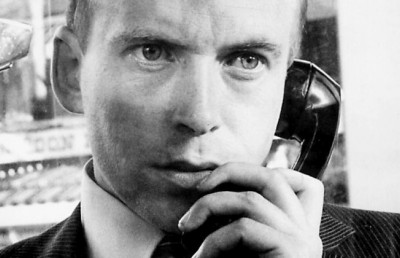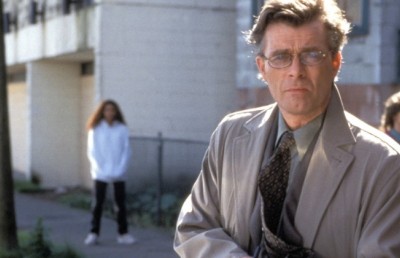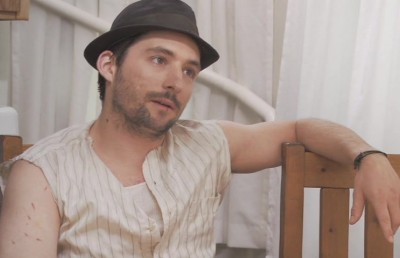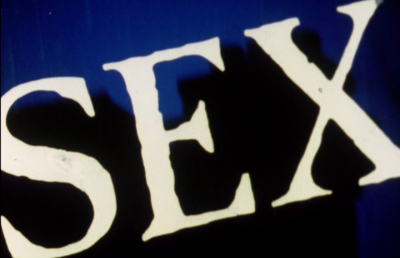A Rite of Spring: Notes on Allan King’s The Pemberton Valley

Filmmaking in British Columbia may be said to be the preserve of youth; it’s a risky business, and as in almost all provincial centres, there has been little in the way of long-term support or infrastructure to keep a film industry or a filmmaker going. Never short of ambition, however, each generation gives it a try, and in the process reinvents the form, being more or less free to take risks, innovate and to bring its own convictions to the fore. For those learning their craft, the process has often tended to be collective rather than hierarchical, a sometimes accidental, sometimes intentional methodology that has resulted in a body of inventive, ground-breaking dramatic and documentary television programs as well as long-form documentary and fictional features.
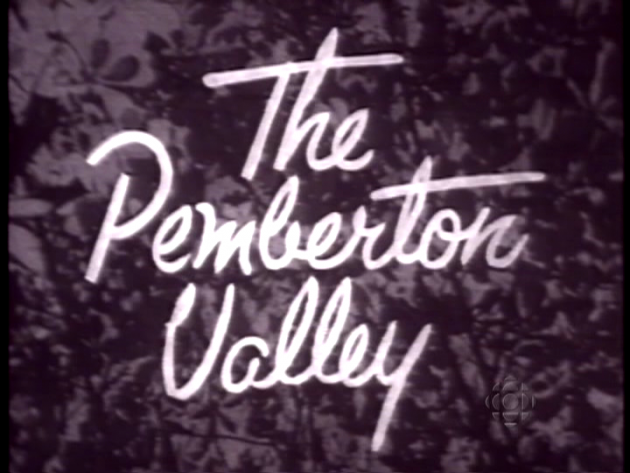
The Pemberton Valley, produced for Folio by CBC Vancouver in 1957 and directed by twenty-seven year-old Allan King, is a convincing example of one of these collaborations. It’s not immediately apparent, for example, where credit might be due for certain decisions or sequences in the film. 1 A sense of enthusiasm, exploration, discovery and earnest sincerity infuses every sequence. The images are lovingly crafted with careful attention to sunlight and shadow; the editing is poetic, with a confident, lingering rhythm; the narration is provocative and multi-layered; and the film as a whole is probably more interesting today than it was when it was made. We’ve come to expect documentary films to advocate on behalf of their subjects, but because The Pemberton Valley adheres to a different tradition it conceals its advocacy and takes, as its subject, time, or, in the language of the day, unredeemable time. It’s a precursor to what today is called the essay film, and to my mind it represents a radical step in terms of its ambitions and in its frank analyses of family, society and race in post-war British Columbia. And at a time when television was new and still attached to the old seasonal rhythms, the film can be seen as having a modest ceremonial function; by choosing the month of May and concentrating on renewal and the idylls of childhood, it performs — along with its subjects — the rites of spring. The film’s overarching thesis is that the return of spring is a universally shared celebration uniting all people, even those living in a hardworking, divided rural community in the Coast Range of British Columbia where the valley is shared by Indigenous communities, pioneers and immigrants. In fact, the existential portraits offered by the film are much more complex. Life in the valley may seem timeless, but its residents are grappling with rapid change. It would be more accurate to say that The Pemberton Valley is an exploration of solitudes.
The Pemberton Valley, Allan King’s second film as director, has been forgotten in the CBC archives for many years. In an interview published in 1976, novelist Sheila Watson speaks of Emily Carr’s paintings as having created a country. Carr’s images, she says, “are viable as a part of history — not because they are representational, but because they have created a way of seeing which then becomes part of the history of seeing in Canada.” 2 The Pemberton Valley is also part of the history of seeing in Canada. It tells us much more than we may wish to know, and perhaps a great deal more than we deserve to know.
When we first spoke on the phone in the spring of 2013, George Robertson, the writer and narrator of The Pemberton Valley, told me about his trip with Allan King and cinematographer Jack Long on the Pacific Great Eastern railway to scout locations in the village of Pemberton. Allan had secured permission to create a film about life in the Indigenous and non-Indigenous communities that live with each other uneasily in the valley. The story would conclude with the colourful annual rodeo in honour of the Queen’s birthday and, with any luck, a coming together of the two communities in celebration. They didn’t know a soul when they stepped off the train.
“You know Allan,” said George, “he’d come up with an idea, and then go out to look for subjects and locations.” 3 In 1956, George Robertson was a twenty-eight year-old radio producer who’d studied Creative Writing with Earle Birney at UBC and gone on to the Creative Writing Workshop at the University of Iowa. He’d published fiction, written radio plays and documentaries and directed comedy and jazz for CBC Radio. One of his radio documentaries had caught the ear of Allan King who asked him to collaborate on his new project. George and Allan had once lived in the same house at the corner of Chilco and Comox streets in Vancouver’s West End. 4 George’s plainspoken, carefully crafted narration for The Pemberton Valley would be his first writing for motion pictures. 5
The Pemberton Valley is regularly cited in King’s filmography and is always included in the list of achievements by which we recognize the enthusiastic young filmmakers attached to CBC Vancouver in the mid-1950s. Jack Long told me, when we were working together one day in the 1980s, that he preferred The Pemberton Valley to Allan’s first film, Skidrow, which he also shot. When I first screened the film I saw why: the light, the mountains, the rural landscapes, the subjects, the families, the overlapping, often contradictory layers of history, culture and language, and, for a sensibility tuned to visual revelation, the opportunity to film what had never been filmed before, to make sense or to find meaning in the synthesis — if indeed one could be determined — between the two I’s, the “Immigrants” and the “Indians,” the deposed custodians of the valley. This is just a guess, but I suspect that Jack quickly felt the tensions between the Indigenous and the non-Indigenous communities, a tension of contraries, akin to magnetic poles, drawn to and repelling one another. Here was a dramatic potential. Today, perhaps unsurprisingly, the film is not well known in the village of Pemberton. There’s a VHS copy at the Pemberton Library and Archive 6 In the Lil’wat community at Mount Currie, the film is better known and occasionally screened; it offers the opportunity to see and recall family and community members as they were almost sixty years ago.
The film’s cinematic antecedents can be found in the British and European documentaries that were shown as part of the Vancouver Film Society screenings at the Stanley Theatre in the 1940s and 1950s and which were attended by many in Vancouver’s small artistic and literary scene. Stan Fox, who hired Allan King at CBC Vancouver, had been a projectionist at the Stanley, responsible for choosing the music for silent classics. If there’s a hint of Humphrey Jennings in The Pemberton Valley, it’s evident not only in the poetic camerawork and montage, but in the structuring theme and narration which owe much to the literary scholarship of the day. One powerful strand of documentary originated as a literary form, dependent on written and spoken language and relishing its classical references and textual sources. Its makers were often students of literature and philosophy, and they cut their teeth producing short films for the state or for commercial interests. The celebrated films of the British documentary movement may be seen in this light, in apparent contrast to the expressionism and thrusting montages of the European avant-garde. The humanism of The Pemberton Valley, it seems to me, with its source in Anglo-Canadian pragmatism, borrows from this literary tradition, but we should also see its lyricism and mythic thinking as a way of responding to the intolerance and betrayal of twentieth century ideology.
In order to locate or impose form on the unfamiliar world of the Pemberton valley, Allan, George, Jack and their editor Arla Saare borrowed liberally from Anglo-American literary, philosophical and aesthetic Modernism. Given the dramatic potential of the divided communities, the film must have proposed itself early on as a play of correspondences. Northrop Frye’s 1951 essay “The Archetypes of Literature” could have provided a blueprint for a number of the film’s sequences with their structural binaries of spring and fall, dawn and dusk, the familiar and the Other, its dreaming girls, epic youth on horseback and struggling husbandman:
The human cycle of waking and dreaming corresponds closely to the natural cycle of light and darkness, and it is perhaps in this correspondence that all imaginative life begins. The correspondence is largely an antithesis: it is in daylight that man is really in the power of darkness, a prey to frustration and weakness; it is in the darkness of nature that the “libido” or conquering heroic self awakes. 7

Afternoon sunlight and shadow pervades much of The Pemberton Valley with backlit clouds of dust, haloed hair, shimmering grasses and trees. As darkness falls, the film concludes with a union of the contraries — the coming together of the film’s two families — followed by a final beam of light as the sun sinks behind the mountains. Time — which has allowed for a twilight moment of unity — reasserts itself, suggesting that what coheres will also fall away again. As The Pemberton Valley was being completed, the remaining resident of Stanley Park, Tim Cummings, a man with Native and non-Native heritage, died in Vancouver. 8 The Park Board demolished his cottage immediately, destroying any evidence of habitation in order to make way for unchallenged development. The erasure of Cummings’ home must have seemed to some like a final blow to the right to live on one’s own land, in the location where one’s ancestors had lived. Perhaps this is why, on screen, the settlers in the Pemberton Valley live in a world of early summer light while their neighbours, the Lil’wat, true to the system of binaries, are seen to dwell in the shadows, traumatized and alienated from the harvest they once gave thanks for.
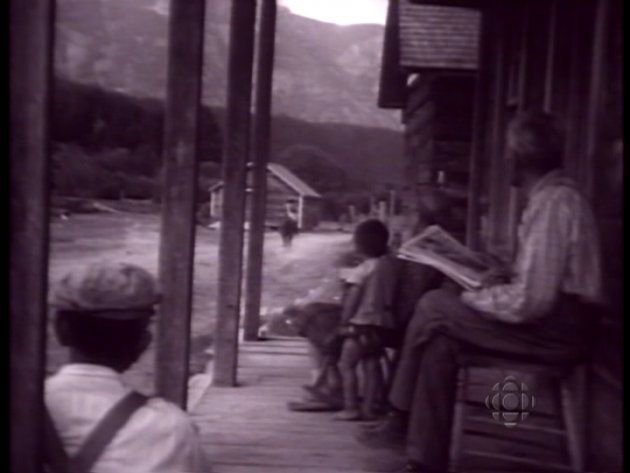
The post-war, post-colonial world was everywhere in a traumatized state. Intellectuals and artists, seeking a way out of the destructive magnetism of war capitalism and atomic destruction, turned again, as they had in the 1930s, to the communions and transformations promised by mythic thinking. Students of literature at mid-century like King and Robertson would have been familiar with Freud, Claude Lévi-Strauss and Northrop Frye who saw in archetypal myths the structural dynamics of the unconscious mind as it played itself out in pre-Modern cultures. The notion that these archetypal structures are universal and that they reveal deep currents in human culture allows us to see why The Pemberton Valley, while officially a regional production intended to celebrate scenic landscapes, the successful integration of immigrants and the province’s growing economy, turns its attention to the intersection of time and transcendence rather than to the immediate political situation on the ground. Mythic thinking identifies correspondences and allows for a redemptive union of contraries in a time of acute pessimism. Time is cyclic, a turning wheel that’s greater than any human conflict or resolution. The light will return to replace the darkness.
In keeping with mythic thinking, the dramatic structure of The Pemberton Valley is symmetrical, designed to expose the tension between and the interpenetration of contraries. Frye suggests in “The Archetypes of Literature” that the organizing principle of art and life is “recurrence” which, he suggests,
…is deeply founded on the natural cycle, and everything in nature that we think of as having some analogy with works of art, like the flower or the bird’s song, grows out of a profound synchronization between an organism and the rhythms of its environment, especially that of the solar year…In the cycle of human life, there is a single pattern of significance, out of which myth constructs a central narrative around a figure who is partly the sun, partly vegetative fertility and partly a god or archetypal human being. 9
One of the central figures in the film is a farmer named Lukey Van Beem whose life is ordered by the cycle of seasons. Even his name is appropriate. If the world is governed by recurrence and by a single pattern of significance, one might ask: is one’s destiny already decided? I can imagine Allan King answering in the words of William Blake, “Pity would be no more / If we did not make somebody Poor.” 10
The film’s fifty-nine minutes are scrupulously divided into halves. In the first, the seasonal rhythms of the Van Beem family are introduced within the context of spring’s return to the valley. All is in transition. The theme is rebirth and transformation. Robertson establishes a lightly inflected voice that addresses us directly, a tone that takes us into his confidence. Later on it will include a touch of irony:
The Pemberton Valley is a place by itself, locked in by the mountains a hundred miles from Vancouver. Spring is here very sudden. Overnight, the skunk cabbage is flowering and the pussy willow is in bloom. The snow has begun to melt from the mountains, and the ice thaws in the Lillooet River.
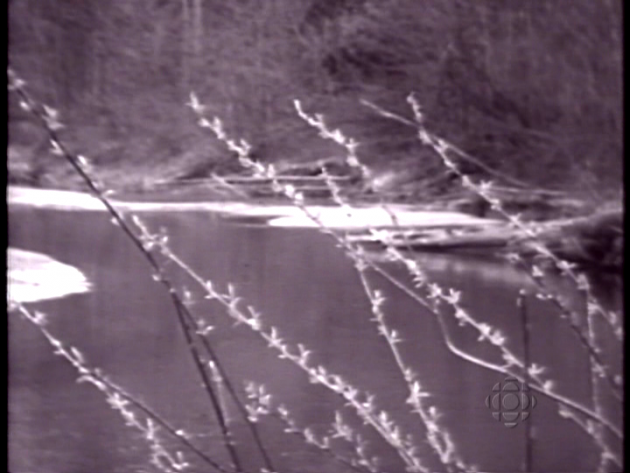
The Valley is isolated, its people are self-reliant and their internal clocks move to the rhythms and cycles of the natural year. Should we be thinking of Shangri-la?
It’s a sunny afternoon in May, and the Van Beem children are introduced in the “school bus” as it makes its way to their farm gate. The narrator explains: “This film is about the Pemberton Valley in springtime, and partly about these children, four distinct and determined personalities.” Two of the children are foster children, and the narration immediately sets about analyzing them. About Vern, a ten year-old boy, Robertson tells us:
Sometimes the effort to be grown up is too great, for Vern at ten years is a very complicated person. In his life before he came to the Van Beems he was unhappy and uncertain. Now that he’s part of a family, among people he can trust, some of the tension is gone, the barriers are coming down, and his playful and affectionate nature is beginning to show through.
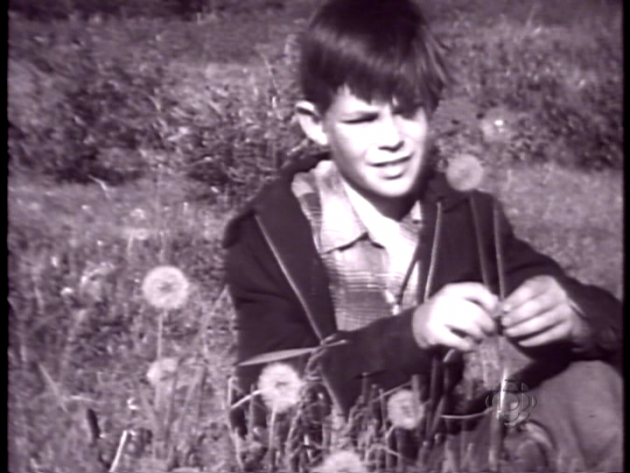
Is this possibly a film about barriers as well? It should be said that the camera does not show Vern as a “very complicated person.” We must accept the narrator’s word, but how has he decided this? There follow sympathetic case studies of the teenaged girls in the family. Here’s a description of Elaine:
She was raised in the city and came to the Van Beems only six months ago. She’s fourteen, and beginning to be aware that she’s pretty.
Like Julia, she can escape in her work to another world, the world of her past life, perhaps. Nobody knows quite what she thinks about. She’s more outgoing than Julia. It’s easier for her to mix with people, and like Vern she calls Mrs. Van Beem Doris.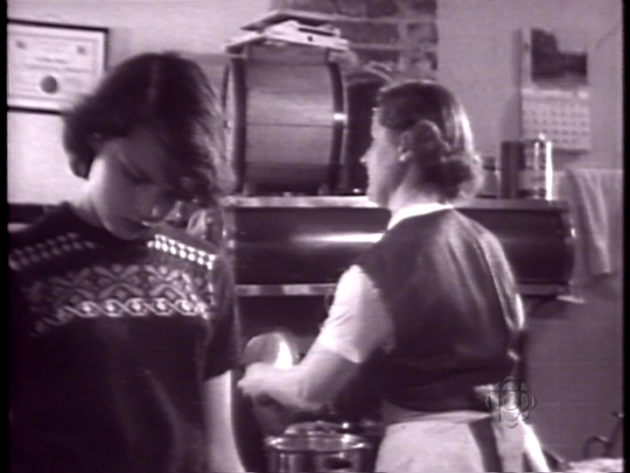
And here’s Julia:
Julia making her bed is really only half thinking about what she’s doing. She moves automatically, as in a dream. It isn’t that her mind is fixed clearly on something else; she seems rather to be roaming in her imagination from one thought to another. A teenage characteristic, you say? Perhaps, but especially a characteristic of Julia.
Yes, it’s difficult to keep your mind on one thing at a time, but in the pages of a magazine there’s a life of fantasy quite apart from the life she knows, the everyday life of school and the farm, and to Julia it looks tremendously attractive.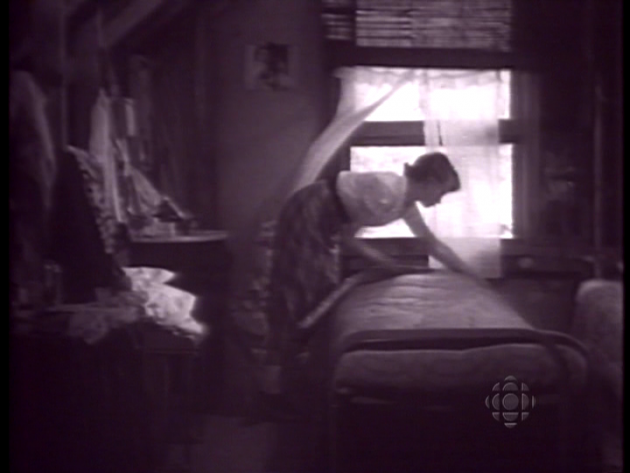
In keeping with the documentary genre, there is something intentionally archetypal and metonymic about these portraits. Julia is acting; she has been asked to go into her bedroom to make the bed and then to gaze longingly at the images of elegant women in Life magazine. In a dramatization like this one wonders if the film is really about the Pemberton Valley at all. Something more complex is going on. An omniscient male narrator articulates the inner thoughts and feelings of a young woman who’s acting the part of herself at the filmmakers’ request. What we hear may or may not be an accurate interpretation of her behaviour, for the narrator wasn’t present, but perhaps the point is that the dramatized sequences in the film instruct us as to the limitations of the moving image — which move it toward metonymy. The Pemberton Valley reminds us of what cannot be seen. No matter what we’re shown, the visible plane is at best a refraction of the invisible plane that governs it. On the other hand, the full exposure of the invisible plane — the unconscious — in such a film would be incendiary. With a calm voice, the tension between the seen and the unseen is acknowledged but not engaged.
The Allan King whose family life was complicated and who went on to make Warrendale ten years later is apparent in the film’s observations about children’s emotions and in its brief dramatic sequences, each requiring a laborious formal set-up. In the scenes with audio dialogue we can hear the beginnings of what he would come to call an “actuality drama.” In the late afternoon sun — much of the first half of The Pemberton Valley is shot at magic hour — Vern, the foster son, rides down to an outbuilding with Lucille, the Van Beem’s oldest daughter, to deliver salt and minerals to the calves. He jumps off his horse and the next shot finds him in a field of glowing dandelions that have gone to seed. He picks a bouquet and offers it to Lucille who is getting on with the chores.
Vern: “Lucille, will you marry me?” he asks. He blows the seeds in her direction.Lucille: “Oh, Vern, cut it out and go get the calves.”
Vern: “Kay.”
The impulses of spring are innocently played out here in mythic context: Vern becomes the fatherless knight who enters the hidden valley to woo the king’s daughter. Was this an artfully crafted analogy, or was it somehow unconscious? How are we to understand such a curious courting scene? George Robertson told me that he did not write the conversational sequences, although he admitted that he may have suggested a few things like the corny joke that Lukey makes about “salt running out of their ears” when his kids ask him about delivering minerals to the animals. 11 Allan, he said, had asked him after their first visit for a “template,” for something like a shot or sequence list. “I wanted to tell a story that was based on reality and that had the structure of good fiction or drama,” George told me, so he prepared a loose structure. Allan chose what he wanted, he said, and most of the staged conversations, which were designed as hinges between scenes, were devised in the valley during the shooting period. 12
Sound technology was fairly primitive — synch sound was several years away — yet the film contains a number of dramatized, pre-scripted conversations between members of the Van Beem family and their neighbours. However wooden the dialogue may sound today, the tentative and improvised nature of these sequences adds a layer of vulnerability and intimacy to the film. We’re captivated as we watch the family members struggle to act out the identities proposed for them. King and Long must have been excited by the chance to create dramatic sequences, but it’s the struggle of each family member to pretend and to please that endears the Van Beems to me.
The staged dialogue sequences with the Van Beems would not have seemed unfamiliar in 1957. Tellingly, however, there are no dialogue sequences in the second half of the film, shot almost entirely in the village formerly called Creekside on the Mt. Currie Indian Reserve. In contemplating dramatic dialogue sequences on the reserve, King would have had to take into account the cultural and linguistic context — and his ignorance of the peoples’ lives. Relations between Indigenous and non-Indigenous people, as the narration explains later, lacked trust and respect. King may have felt comfortable improvising mini-scripts for the Van Beems, but he’d have been at a loss had he tried to craft lines for the family of Roger Leo, the fifteen year-old Lil’wat boy who is at the centre of the film’s second half. Culturally, he’d have been out of his depth. Which language would he use? How would he ever begin to hear cultural nuances; how could he ask someone to record a scripted joke? And white men often made fun of the way Indigenous people spoke, a particularly hurtful and humiliating form of racism he would not have wished to encourage.
The absence of dramatized dialogue sequences in the second half creates the impression that The Pemberton Valley has transformed itself into an anthropological film. The irony can’t have escaped the filmmakers; the people whose ancestors have called the valley home for 10,000 years are silenced, subject to racial and cultural generalizations, while the settler family is represented as “normal” and hard working. Lukey Van Beem, the patriarch, with his Dutch accent, perhaps eludes both categories; he says barely a word. When he arrived in the valley, he was a “foreigner” and was treated as one. We’re told that he left Java in the late 1920’s, likely in reaction to political instability and anti-colonial agitation. According to the narration, when he first arrived he was called “the Wild Man of Borneo” due to his hot temper, symbolically placing him in the camp of the Indigenous Other, whereas in his old home he would have been the Other’s colonial overseer. After thirty years he seems to have shed his “foreign” skin. Lukey appears to fit the archetype of the exile who wanders the earth in search of forgiveness and redemption.
A close examination reveals that each of the dramatized dialogue scenes in the Van Beem sequence is a transitional hinge that illustrates the cyclic theme. Doris, for example, is in the kitchen talking on the phone to arrange matters with her neighbour Noreen who’s coming to help plant potatoes the next day. Julia stands next to her, eating an apple (!), trying to get a word in:
Julia: “Mum, is it OK if I put my bathing suit on?”Doris: “I thought you were going to do your homework.”
Julia: “I am. I’m going to go to the island and read.”
The scene cuts to Julia in her bathing suit on her way to the river in the raking sun and shadows of late afternoon. The forest is lit up and she dawdles as she goes — as directed — examining leaves and berries along the way. A shot lingers on her legs as she strides through the horsetails in the late afternoon sun. The narrator picks up the thread of her interior monologue.
Spring is a time of discovery. These things Julia has looked at year after year before. Now she suddenly sees them. Now her walk through the woods has become a voyage into a strange land, and she doesn’t know why she feels happy and sad at the same time.
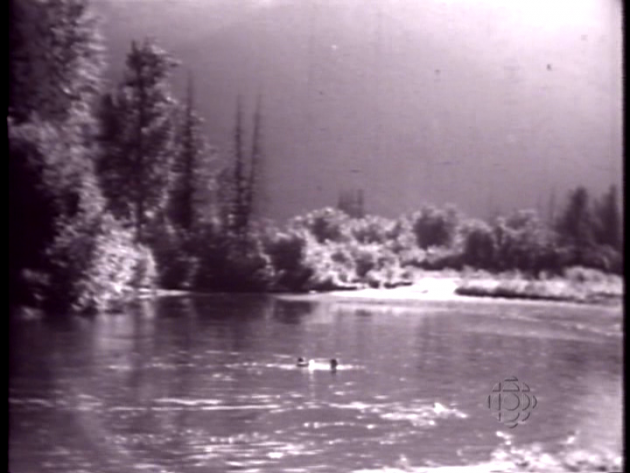
She arrives at the river where Vern and her sisters are swimming like puppies. The scene is suggestive of classical antiquity except that it’s being played out in the culture of 1950s British Columbia where the frolicking children are oblivious to the expulsions that cleared most of the valley. The narration recreates childhood as a time of carefree animal vigour, then plunges the listener into the transcendent heart of this film in which the egos of the children are said to disappear in a surge of ecstatic union with the natural world. The Van Beem children become incarnations of the idealized child, liberated from time and space, from self-consciousness and the social or political order. Robertson’s rhapsodic narration makes this more or less explicit:
Spring has come tumbling out of the mountains and touched these children with its exuberance. In their clowning and splashing there is no self-consciousness, no embarrassment. Their play is as simple as an animal’s. How many of us would not like to be as free and as uncomplicated and as happy as this? Happiness is not an idea that a child thinks about very much. It is only an adult looking on who says, “This child is happy,” or “This child is sad”’ or who, looking back, says, “Then I was happy”’ or “I was never happier in my whole life”. But the child, even a child as grown up as Lucille, only knows the sun and the water and the bright trees, and gives themselves completely to them all.
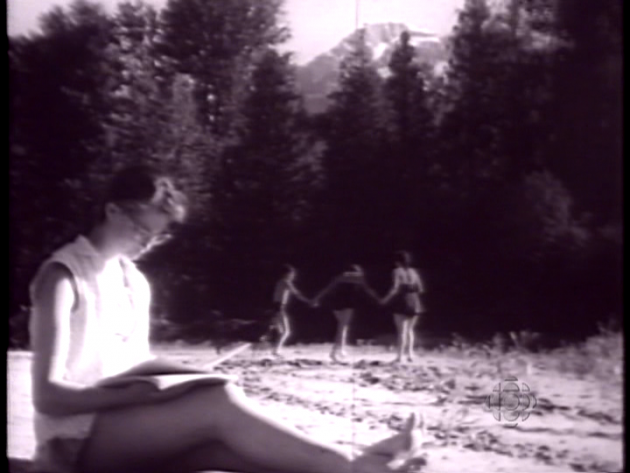
While typing out these words, I was reminded of Dylan Thomas’s 1945 poem “Fern Hill”— a text revered by writers and readers at the time for its cry of resistance in the face of annihilation. Thomas visited Vancouver in 1950, on Easter weekend. His visits —there was another in 1952 — are, or were, legendary for their prodigious nights of drinking at the Georgia Hotel. I asked George if he’d met Thomas in Vancouver and he said yes, he had, he’d attended the noon reading at UBC in 1950, where Thomas read “Fern Hill.” On the morning of April 7th — Good Friday — in the company of Daryl Duke, he’d run into UBC English professor Hunter Lewis on his way to the Georgia Hotel to take Thomas to the airport. Lewis asked the two young men to come along, and as Duke had other business to attend to, Robertson accompanied Lewis up to Thomas’ room. They were ushered in to discover Malcolm and Margerie Lowry sitting on the floor in the middle of an animated conversation with Thomas about the moving candelabra in Jean Cocteau’s La belle et la bête (1946). 13 They’d likely been there all night. Asked if “Fern Hill” had been in his mind while writing the narration for The Pemberton Valley seven years later, George said no. When I suggested to him that the narration read as if it had been composed by someone steeped in literary culture, he replied, “I was just being a kind of romantic poet.” 14
If the Van Beem teenagers in The Pemberton Valley are related to young shepherds and their lasses engaging in a rite of spring, their parents take it to the next stage, digging the furrow and planting the seed. An unmistakeable melody, borrowed from Virgil Thomson’s score for The Plough the Broke the Plains (1936), accompanies Lukey, his wife Doris and two neighbours as they sit astride the farm equipment, ploughing the rows, cutting up seed potatoes, placing them in a shallow circular dish with holes at regular intervals that allow the potato slices to fall through, evenly distributing them along the furrow. Robertson’s narration tells us that,
…planting requires too much concentration for them even to be aware of the beauties of nature…Planting is hard work, and after a few hours it seems as if they’ve been doing it all their lives.
Again, the subjects are analyzed, like the children at play, and found to be in an altered state, at one with their work like a single human machine; focus, concentration and attention to the moment has liberated them from time. Have they been in the field for a day or forever? Is this the film’s way of reminding us of eternity, and of the illusion of the material world?
Edited by Arla Saare, 15 a poetic montage of turning wheels is inserted into the potato planting sequence: the tractor’s wheels, a cog-wheel on a shaft, the discs that close up the furrow, and the rotating dish with the seed potatoes recur in rhythm, taking on abstract forms in close-up. It’s the type of sequence familiar from industrial or expressionist montages in avant-garde European cinema. The synchronous wheels in a Pemberton potato field, carefully framed by Jack Long, suggest armatures analogous to the human body, ready-mades in motion, and — it’s impossible to confirm this now — perhaps they’re also intended to symbolize the seasonal cycle, the eternal recurrence that, in the mythic dimension, is understood to be a universally shared experience. Which is to say that in the great scheme of things all men and women are created equal—equally vulnerable and equally destined for transcendence. I’m reminded that one of the bellwether cultural events in the West during the 1950s was a 1955 photographic exhibition at MOMA entitled The Family of Man. Curated by Edward Steichen, it sought to represent the dignity and genius shared by every human soul. It proposed that the values associated with family love, dignity and tenacity, represented by images of suffering and joy, are universal. Behind the photographs lay the U.N.’s “Universal Declaration of Human Rights” (1948) and its post-war promise of universal equality and prosperity. I suspect the “Declaration” would have placed into stark relief many everyday interactions in the Pemberton Valley.
If The Family of Man was an effort to forestall nuclear war by celebrating equality between all races and cultures, it did so by reminding viewers of their fragility and dependence on natural cycles. It was a compelling message. In the face of calamity, the myth of the eternal return offered the promise of transformation and purification. Students of the humanities in the Anglo-American-Canadian world were drawn to the final lines of T. S. Eliot’s “Little Gidding,” published in 1942:
We shall not cease from exploration And the end of all our exploring Will be to arrive where we started And know the place for the first time. 16
In Vancouver, King and Robertson would have been aware of the cosmic or “luminous wheel” in Malcolm Lowry’s 1947 novel Under the Volcano, written in a shack at Dollarton and read by anyone at the time with literary ambitions (while Lowry and his wife were familiar patrons of the Vancouver Film Society screenings). In his letter to Jonathan Cape in defence of the novel’s structure, Lowry explains its symbolism:
This wheel is of course the Ferris wheel in the square, but it is, if you like, also many other things: it is Buddha’s wheel of the law (see VII), it is eternity, it is the instrument of eternal recurrence, the eternal return, and it is the form of the book; or superficially it can be seen simply in an obvious movie sense as the wheel of time whirling backwards until we have reached the year before. 17
It was also the time of Robert Graves’ The White Goddess, Northrop Frye’s Anatomy of Criticism and Mircea Eliade’s Cosmos and History: The Myth of the Eternal Return. Each offered a key to unlock the relevance of ancient myth for a world that had become a wasteland. These works constituted the mental apparatus of young men trained in literature and the arts in English Canada in the 1950s, several years before the introduction of Marxist critique, and their influence is apparent in The Pemberton Valley Viewing the film for the first time in many years, George Robertson said:
It was certainly a work of its time. It might, I think, be seen as condescending today, but if you judge it as an artifact of the 1950s, it was probably fairly typical. Less than a decade later, This Hour Has Seven Days and the rise of cine-journalism made us all approach our material much more critically. Pemberton was an artifact of that brief period when we were all apprentices… We were in the romantic stage — before we became political. 18
In “Nature and Nature Conquered,” first published in 1962, Henri Lefebvre critiques the social construction of the Eternal Springtime and its symbolic system: “The discovery of spring — that is, its conquest — could figure as an episode in that unconscious epic poem we call the life of social man…We humans will always have to conquer our springtime, and create it.” He views the seasonal trope of rebirth and renewal in dialectical terms, however, proposing that the dissolution of ego into an ecstatic union is momentary, the agent of its own division and demise:
With the discovery of spring a unity is inaugurated between man and Nature, between necessity and freedom, between “subjectivization” (the formation of consciousness) and objectivization, and man puts down roots in the world, establishing controls over nature. But no sooner have we formulated these propositions than we must modify them. On the one hand, this unity is soon undermined by the appearance of new rifts; on the other it is not adequate for a complete definition of the man who, in his newfound Dionysianism, immediately remembers that he drinks without being thirsty and makes love in every season of the year…. 19
Lefebvre is concerned with freedom and necessity; in his (Marxist) analysis, the romantic ideal of cycles and wheels is a tyranny. With respect to freedom, he writes, “…first and foremost freedom consists in not accepting necessity.” 20 Lefebvre’s words will, I believe, shine some light onto the second half of The Pemberton Valley, as will his suggestion that irony is the mode through which to combat the excesses of Modernism.
Lukey Van Beem and his family would easily find a place in “The Family of Man.” He is shown to be anxious and worried much of the time, but his strength of character, which seems to come from a strong moral centre, will, we are assured, carry him through.
The farm is Lukey Van Beem’s life, and it always will be. Hard work, never sure of his markets, never sure whether some freak of weather or disease will reduce all his work to nothing…but there’s something that others will envy: his independence, the security of his home and family, his closeness to living and growing things, in fact all the wholesome virtues that we’re becoming too embarrassed to talk about anymore.
Lukey embodies genuine settler and immigrant virtues, which include being grateful and not rocking the boat. Given the history of British Columbia, viewers in 1957 would have been curious to see how the film represented the Lil’wat people living five miles east of the town of Pemberton. After the commercial break, Lukey drives into town in his Model T to buy weed-killer from the Co-op. He engages the manager in a conversation that turns into a pedantic recitation of the available weed-killers. The camera moves outside to follow a fifteen year-old Lil’wat boy named Roger Leo picking up a stack of newspapers on the railway platform.
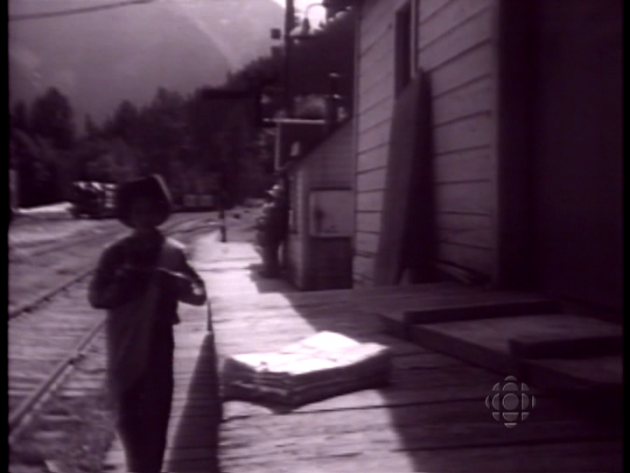
He’ll deliver these to “the old village of Creekside” on his sixteen year-old horse, Robin Hood. The narrator explains:
Roger does not feel comfortable in Pemberton. Like most Indians he’s shy and reserved with members of the white race, shy even among his own people. Pemberton is not unfriendly to its Indians, but there is the barrier between races, and on the other side of the barrier the Indian always take second place.
The barrier again. The orchestral music is drawn from The Plough that Broke the Plains, an unintended cruelty perhaps. Roger rides up to his house and in a dramatic but silent scene his sisters on the front porch help him fold the papers so that they’re ready for delivery. We’re told, “This family, like the Van Beems, lives very closely together, with a strong and simple sense of loyalty to one another. What Roger does is of great interest to his sisters.” The isolation of the children at Mt. Currie is mentioned several times. We are meant to contrast this to Julia with her Life magazine, imagining escape. Roger’s sisters do not appear to have that desire, although his oldest sister, Lorraine, has been chosen as this year’s May Queen and her mother is sewing the gown for her coronation. Because they do not speak, the narration devotes considerable time to analyzing the Leo children, although Robertson was not present during production. One finds in his text a range of representations, opinions and attitudes that run the gamut from candidly supportive and sympathetic to troubling and stereotypical. We should accept his goodwill but remain alert to inaccuracies, clichés and insupportable assumptions. On some occasions he’s more candid than a narrator might be today. Still, the larger question remains: if Robertson only went to Pemberton for a day or two to scout locations and search out families, and did not spend much time with either the Van Beems or the Leos, how are we to accept his narration? The Pemberton Valley is clearly not an anthropological document. It may be accused of being patronizing, or condescending as Robertson suggests, but on the other hand it’s typical of the type of dramatic monologue created prior to synchronized sound to support the moving image. Some of its assumptions and interpretations are troubling today, but there are layers in this text, and one would do well to listen to it carefully, the way one might read a contemporary literary or journalistic article. It reveals much more about the well-meaning artist/scholar of the time than it does about the residents of Creekside, which is not surprising. It’s quite possible that the people of Creekside did not really wish to be spied on by the camera.
The larger question throughout the second half of the film is this: did King, Long and Robertson intend us to read between the lines, in the gap between the images and the narration? And if so, what was their intention? Did they find themselves glancing over their shoulders at the CBC; were they concerned with the social conventions of the day?
We note that the themes of rebirth and transformation that drive the Van Beem section are not readily apparent in the old village at Creekside. The reserve, with its two rows of wooden houses on either side of a muddy road is in striking contrast to the Van Beem’s farm. Life is different here, perhaps poorer, more enclosed. At first glance the village is reminiscent of an internment camp.
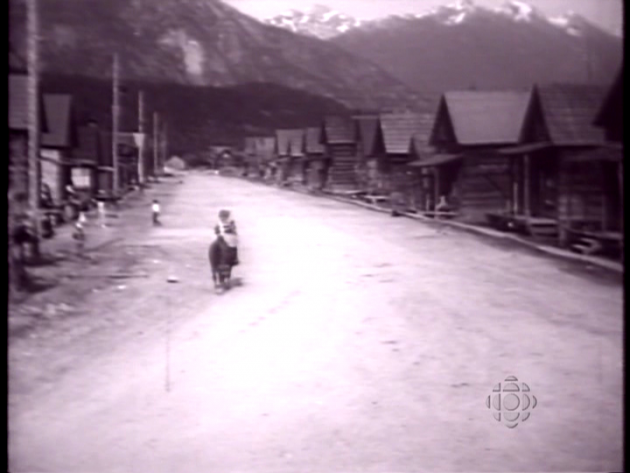
Roger delivers newspapers to the families sitting on their porches. Robert Hunter’s accompanying orchestral “rhapsody” entitled “The Indian Village” employs the pentatonic scale and tom-tom. Robertson asks,
How disturbing it is that the Indians don’t seem to do anything, but is this so bad? Would they be happier working to buy a refrigerator? Some of the younger ones think so. There are those in the band who feel that the Indian must advance to survive, that he must get an education and look for the day when he can compete on equal terms with the white man. There are others, the older ones, who are proud of the traditions, and resent any efforts to change them.
Later on we’re introduced to Roger’s father Adolf. He can make good money if the logging company is hiring: “There’s little incentive for the Indian to work the land he’s been granted, much to the irritation of the whites who’d like it for themselves,” we’re told. And the truth is exposed.
His papers delivered, Roger turns away from the village and walks Robin Hood down a road, across a bridge — it’s magic hour again — and the two enter a meadow. What follows is an epic gallop through the slanting sunlight of a May evening.
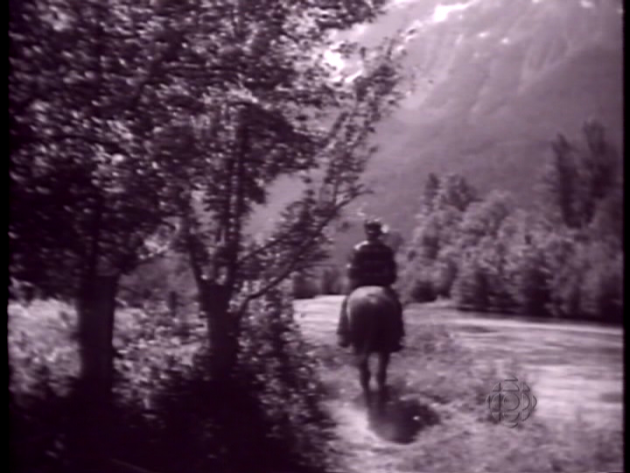
This is the great, magical sequence in the film. Roger and Robin Hood fuse into one; unity’s grace is bestowed, it seems, only in childhood. The narration explains:
This is Roger’s country. He has never known any other. And because he knows it well, he loves it. These fields and trails and creeks have been his playground for fifteen years. His ancestors shot deer in these woods, picked berries on the mountains and let their animals run free. They took their possession for granted, for as much of the world as they could see was their own. Now times have changed. The fields and the trees and the grass have been given to the Indians. They’re no longer theirs by right. Roger will be leaving all this in a little while. In June he will be graduated from Grade Eight, and the school in Mt. Currie doesn’t go any higher. Roger is a good student and his teacher wants him to go to William’s Lake next year where there’s an Indian high school. It means being away from home for the first time, meeting strange people. Roger’s not looking forward to it, but he knows that it is the right thing to do.
One feels a chill today knowing that this boy racing through the high grass on his beloved horse will become an inmate of St. Joseph’s Mission in Williams Lake, one of the most notorious residential schools in British Columbia. Why must he go to an Indian high school far from home, a school his parents are not permitted to visit, where his own language will be forbidden? Why is he not attending the same high school as the Van Beem girls, with a bus to bring him home? Why will he be peeled away from his community? There is a sense of finality, an aching feeling that this moment on Robin Hood — the thief of time, the bringer of joy and ecstasy — may never recur. This may be the happiest Roger will ever be. Like the Van Beem kids in the swimming hole he’s liberated from time and language; in a few months, like the others, he will become their prisoner. The narrator tells us:
The spring air has wafted down the valley, and under the shadow of Mt. Currie, Roger and Robin Hood together embrace the sun and the wind, an old horse and a young boy, sharing the exhilaration of their power to ride over the ground as if they had wings. In this companionship, Roger is able to express better than he ever could in words why he is happy to be alive and a young Indian growing up in Mt. Currie.
In contrast to the mythic sequences in the first half, at forty-four minutes there’s a cut to images of what seems like utter despair. Members of the brass band in the village pose silently for the camera with the saddest, most haunted faces I have seen in a Canadian documentary film.
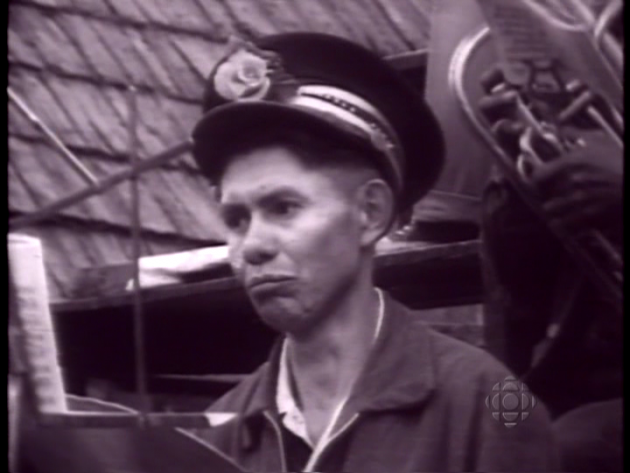
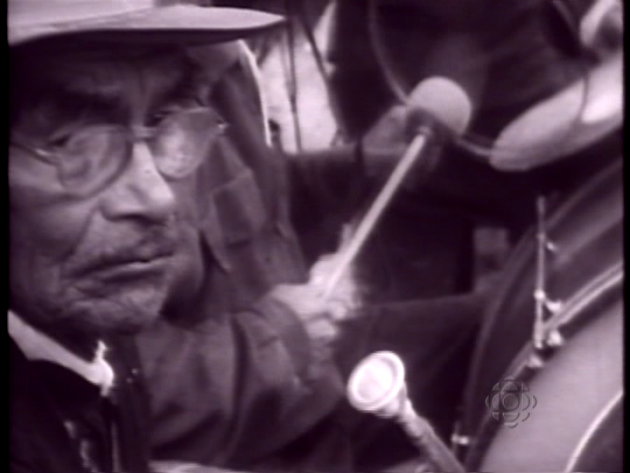
It’s May Day, and the village has maintained the tradition of celebrating Queen Victoria’s birthday with a May Pole dance, the coronation of a Queen, and horse races down the main street. It looks as if it has been raining for days. The street is muddy and rutted and the sky is dark and cloudy. Somehow the faces contribute to the sense of pathetic fallacy. Lorraine has a crown placed on her head and shyly speaks a few tentative, rehearsed words into the microphone. The narrator comments: “The new Queen waves to her subjects and the old Queen looks sad, and the flower girl looks as if she would rather be home in bed.” Then the girls dance through the puddles, around the May Pole and in a kind of precision drill in front of the new Queen and her entourage. It’s a formal performance, part of the ceremony. The narrator reflects, and as he does he inadvertently defines his viewers as “we,” placing the residents of Creekside outside the charmed circle of his audience.
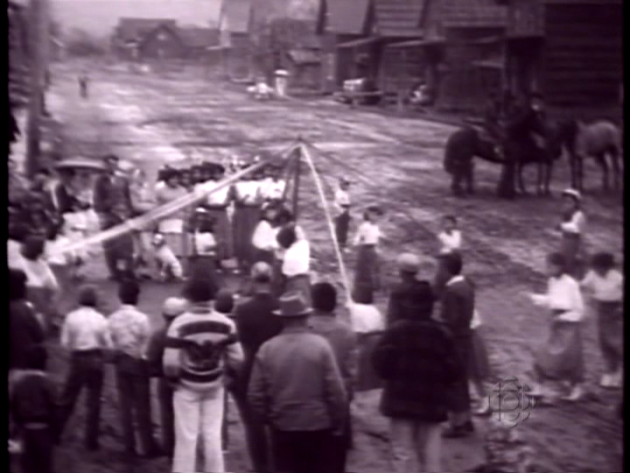
To us the dance may seem a little sad. But that is because we have trained ourselves to look at things in a complicated way. We prefer our ceremonies impersonal and streamlined. But among these children, whether watching or taking part in the parade, everyone is a participant, and that feeling of belonging or closeness, that family feeling runs through all the antics to follow.
But are we to believe this condescending statement? Certainly life on the reserve must be complicated. But the crowd is large, some people seem to having fun, and clearly the village welcomes visitors from the surrounding district, some of them, along with the Lil’wat kids, waving Union Jacks. The ceremonial expressions of loyalty to the British Crown that may surprise some viewers very likely represent the community’s expectation that negotiations regarding sovereignty over their stolen, unceded territory must be conducted with the Crown, from whom they’re expecting justice, and not with unreliable Canadian governments.
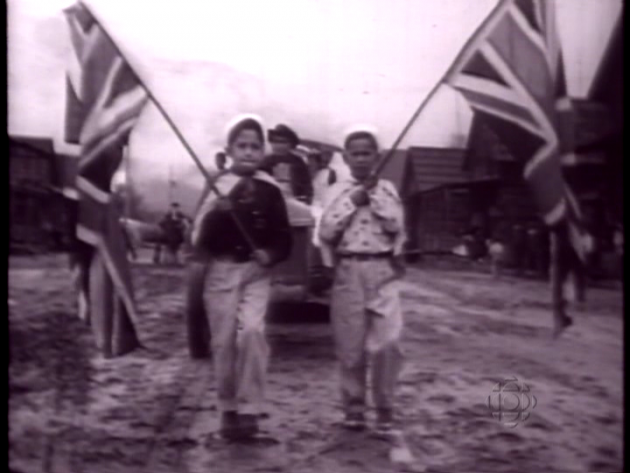
Following the dances, a wild man is led at the end of a rope down the muddy street between the wooden houses, straining to escape. He’s a captive Sasquatch, and he leaps out at little children to frighten them. He’s accompanied by a man wearing a feathered headdress and beating a drum with a stick. The drum is a gasoline can. This is followed by horse races through the mud. They’re slightly chaotic and informal and draw a big crowd. The start line is drawn on the main street with a stick. Dogs chase the horses and children wander into their path. There’s a lively betting scene. Roger races Robin Hood, who was once, we’re told, a top racing horse, but he’s too old now to win a prize. A young man from the village sings a country and western song into a microphone. With unexpected candour, the narrator explains what he takes to be the facts of life in British Columbia.
When he was Chief of the band at Mt. Currie, Billy Pascal said many times that the Indian had to live with the white man and learn his ways. They know this to be true. ‘You must fight for equality,’ he said. They look at the white people in the crowd today and they’re perfectly aware that behind the smiles they’re regarded with a friendly contempt.They’re also aware that some of the construction men who live in the nearby camps, perhaps some of them here in the crowd, have given illegitimate children to their daughters. They accept this, as they accept many things, without dwelling on it, barely even speaking of it.
The white man lives in tolerance of the Indian and that is a long way from equality. The Indian doubts he will ever have equality, and in the meantime he will live with what he has.
The intolerable, impossible, insupportable concept of “friendly contempt” is emblematic of the contraries presented in The Pemberton Valley. Justice will find no purchase in that binary.
Finally, it’s time for the rodeo. It’s what everyone has been waiting for. With its bucking broncos and steer riding, the rodeo, the festival of spring at Mt. Currie, is the main feature. Roger takes his chances on a steer — and does admirably, but the film treats the event rather perfunctorily, returning to the characters as soon as possible. Lorraine and Julia appear at the corral, eating hot dogs. Lukey and the rest of the family arrive and they meet up briefly with the Leos. One senses that this conclusion was not only set up (most interactions in documentary films were and are set up), but that this dramatization of the families’ reunion was scripted from the very beginning. The contraries may be united, but the reconciliation is staged. The narrator attempts to convince us:
The Van Beems and the Leos have known each other for many years, one of the rare cases where an Indian and a white man are close personal friends. The Van Beems and the Leos have no thought that their friendship is especially unusual. It goes back to the days when Adolf once worked for Lukey. Such a friendship comes easy because Lukey is a good man who takes people as he finds them, and because Adolf has worked with white men long enough to understand them.
It’s clear that Adolf is the one who must make the concessions. They both know this. And with this restatement, we’re reminded that everything they say and do bears a delicate relation to the unequal division of land and resources, and on this front there will be no concessions. They know this. It’s the unspoken truth, and as we catch a final glimpse of the village’s main street we can see that the history of the twentieth century will continue to play itself out in the shadows of the Pemberton Valley.
To retrn to Lefebvre, and to the faces on the street at Mt. Currie, perhaps what we see (and don’t see, simultaneously) in the Lil’wat refusal to provide cheap labour for farmers, or to buy refrigerators, to integrate into the town’s menacing culture, to work the plots of land they’ve been given, or to alter their traditional ways, is a refusal to settle for what the colonists have offered them. Lefebvre proposes that “…first and foremost freedom consists in not accepting necessity,” and in the case of the families in the village, to shift the context a little, the necessities of manual labour and consumerism are what have been dictated to them. 21 The Pemberton Valley presents their response between the lines, visually and sometimes not so subtly; in their silence is their refusal.
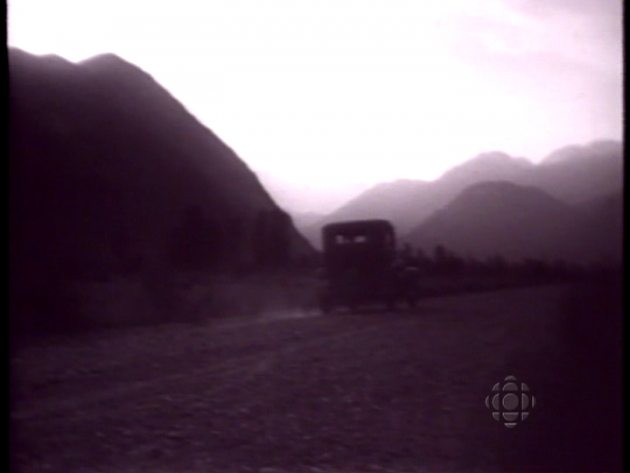
It’s evening, and the light is fading. The glow of magic hour illuminates the dust on the road as Lukey drives his family back to the farm. There’s a panoramic closing shot as the car disappears into a cloud of light in the distance and the sun sinks below the edge of a mountain. The shot must have taken quite a bit of organization; it’s a model of documentary timing. The narrator revives the theme of the eternal return, and perhaps, as George Robertson suggests, ten years later the makers of The Pemberton Valley would have come to a very different conclusion. His words are borrowed from the high romantic style as the Model T vanishes, and they’re also touching and universal:
In a little while May 24th will recede into the past, into another of the days of spring, and the bright mornings of summer and the sharp blue afternoons of winter will take its place. To the children the seasons pass more slowly. Yet when they are as old as Lukey and Doris, and when spring comes again, they will wonder that it happened so long ago.
The Pemberton Valley is a film made by young men and women (Arla Saare was the oldest at forty-one). Allan King and George Robertson learned by doing; Jack Long moved from journalistic still photography to motion pictures. As participants in the literary and arts community in Vancouver, which included their CBC colleagues (Arthur Erickson once told me that when the CBC transferred its best minds to Toronto in 1959 it destroyed the arts in Vancouver), they were able to draw on contemporary Modernist ideas. The television documentary would soon become the domain of men and women, reporters and lawyers, who were more attuned to journalism. Allan King, an iconoclast and a man steeped in music, philosophy and art, went on to become a world innovator in non-fiction film. Arla Saare, who left us on May 9th 2013 at the age of ninety-eight, gave gracious, lyrical shape to his dreams and aspirations until she retired. 22
There’s much more to say about The Pemberton Valley and about the men and women who made it. With this film they advanced the documentary form because they took risks and because they were determined, enthusiastic, curious, sincere and committed — and because, for a few short years, they could. In a province that was not accustomed to seeing itself revealed on film, and where much was left unsaid in public, they presented a complex, unresolved portrait of post-colonial culture. The Pemberton Valley film deserves our attention, for its misunderstandings and assumptions as well as for its achievements. As Sheila Watson might say, it’s “a part of the history of seeing in Canada.”
Acknowledgments
I would like to thank artist and SFU professor Annie Ross and the generous,irrepressible and irreplaceable Colin Preston, formerly the heart and soul of the CBC Vancouver Film Library, for their assistance and observations while I was researching and writing this paper. And I’d like especially to express my admiration for and grateful thanks to George C. Roberston, who enthusiastically shared with me many of the details about the making of The Pemberton Valley. Without his generosity and willingness to meet with me several times, and to review a draft of the paper, it would not be what it is today. Its merits are his; its flaws are mine.
Bibliography
Barman, Jean. Stanley Park’s Secret: The Forgotten Families of Whoi Whoi, Kanaka Ranch and Brockton Point. Madeira Park: Harbour Publishing, 2005.
Blake, William. “The Human Abstract.”
Breit, Harvey, and Margerie B. Lowry (Eds.). The Selected Letters of Malcolm Lowry. London: Jonathan Cape, 1967.
Eliot, T. S. Four Quartets. London: Faber & Faber, 1966.
Ferris, Paul (Ed.). Dylan Thomas: The Collected Letters. New Edition. London: J. M. Dent, 2000.
Frye, Northrop. Fables of Identity: Studies in Poetic Mythology. New York: Harcourt, Brace & World, Inc., 1963.
Lefebvre, Henri. Introduction to Modernity: Twelve Preludes, September 1959-May 1961. Trans. John Moore. London: Verso, 2011.
Watson, Sheila. “Interview / Sheila Watson.” The Capilano Review. Numbers 8/9, Fall 1975/ Spring 1976. 351-360.
Notes
- For more on the collaborative environment of the CBUT, see Tim Newman’s essay in the present volume – Ed. ↩
- “Interview / Sheila Watson,” The Capilano Review, Numbers 8/9, Fall 1975/Spring 1976, 353. ↩
- Telephone conversation with George C. Robertson, 14 May 2013. ↩
- Conversation with George C. Robertson, Ambleside, West Vancouver, 29 May, 2013 ↩
- Telephone conversation with George C. Robertson, 17 May 2013. ↩
- The Pemberton Museum has digitized the VHS and posted it to their YouTube account here: http://youtu.be/CF_fdrWeez8, and five years ago one of the foster children who appears in the film showed up for the first time in thirty years to look for the house she grew up in. Her family has left the valley and the road has been re-routed; she was not able to locate the farm until the second try.[[Telephone conversation with Nicky (Nicole MacPhee) at the Pemberton Library and Archive, 15 May 2013. ↩
- Northrop Frye, “The Archetypes of Literature” in Fables of Identity: Studies in Poetic Mythology (New York: Harcourt, Brace & World, Inc., 1963), 18. ↩
- Jean Barman, Stanley Park’s Secret: The Forgotten Families of Whoi Whoi, Kanaka Ranch and Brockton Point (Madeira Park: Harbour Publishing, 2005), 247-250. ↩
- Frye, 14-16. ↩
- William Blake, “The Human Abstract.” ↩
- Conversation with George C. Robertson, Ambleside, West Vancouver, 21 May, 2013. ↩
- Conversation with George C. Robertson, Ambleside, West Vancouver, 29 May, 2013. ↩
- Conversation with George Robertson in Ambleside, West Vancouver, Wednesday, May 22nd 2013. According to Robertson, “the three of us had breakfast at the Hotel Georgia and then proceeded out to the airport. As we were sitting at the Georgia restaurant, Thomas asked me where he could post a letter, and I offered to take it to the hotel desk and buy a stamp and post it for him. The fact that it reached Caitlin (historical fact alert!) was due to my faithfully carrying out my assignment.” He added: “In the department of trivia, I should mention that when we arrived at the airport, Hunter Lewis left us in his little car (maybe a Morris Minor?) and went in to sort out Dylan’s ticket. Dylan was staring at the button that controls the car horn. He pressed it and there was a beep. He pressed it again. Beep. ‘I wonder,’ he said, ‘if you press it harder would it make a louder noise?’ ‘I don’t think so,’ I said, never having driven a car. He gave the button a powerful bash and the same, rather feminine, beep, sounded. ‘Hmm,’ he said. Then Hunter Lewis returned and we escorted Thomas into the terminal.” George Robertson, e-mail correspondence, 23 May 2013. ↩
- Conversation with George Robertson, Ambleside, West Vancouver, 21 May 2013. ↩
- Saare was head editor at the CBUT and also edited Allan King’s Skidrow (1956), A Married Couple (1969) and his features Who Has Seen the Wind (1977) and Silence of the North (1981). ↩
- T. S. Eliot, Four Quartets (London: Faber & Faber, 1966), ↩
- Harvey Breit and Margerie B. Lowry (eds.), The Selected Letters of Malcolm Lowry (London: Jonathan Cape, 1967), 71. The letter was dated 2 January, 1946. ↩
- E-mail correspondence with George Robertson, 29 May 2013; Conversation with George Robertson, Ambleside, West Vancouver, 21 May 2013. ↩
- Henri Lefebvre, Introduction to Modernity: Twelve Preludes, September 1959-May 1961. Trans. John Moore. (London: Verso, 2011), 148-149. ↩
- Ibid., 145. ↩
- Lefebvre, 145. ↩
- Arla Saare died on May 9th, 2013. Her obituary in The Vancouver Sun on May 11, 2013, reads, in part: “Arla Saare November 28, 1915 – May 9, 2013. Arla, (full name: Arla Agnes Isabella Axelsdotter Saarukka) was the last of her generation and a true Renaissance woman. Her long life of 98 years was difficult in the beginning which made her strong and developed a personality that didn’t suffer fools lightly. She immigrated (sic) with her family from Finland to Canada at age nine just before the depression. Later, showing sharp intelligence, athleticism in sports and exceptional creative talents she graduated from the Vancouver School of Art on full scholarship. Soon she was recruited at the beginning of Film & Television in Vancouver and Toronto where she later became known as the “Mother of Canadian Film Editing” by such notable directors as Alan King (sic) and Harry Rasky and also won many awards for both film and sound editing. This “Formidable Finn” never married, had children nor wanted either. She played baseball in Nelson when young and later Captained the Galiano Island Golf Club where she lived happily in retirement for 30 years. Arla was a role model and advocate for women attaining independence in a man’s world.” ↩



